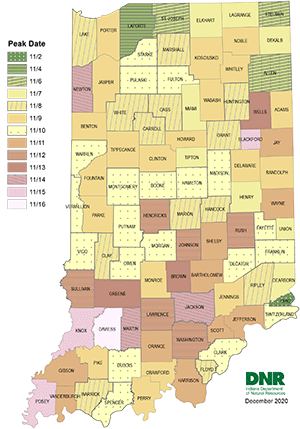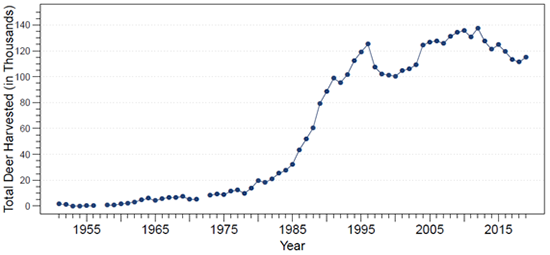 White-tailed deer (Odocoileus virginianus) are Indiana’s only representative of the family Cervidae, which includes mule deer, elk and moose. Deer are common throughout Indiana, as they are very adaptive and can thrive across a wide range of landscapes and habitat conditions.
White-tailed deer (Odocoileus virginianus) are Indiana’s only representative of the family Cervidae, which includes mule deer, elk and moose. Deer are common throughout Indiana, as they are very adaptive and can thrive across a wide range of landscapes and habitat conditions.
History of white-tailed deer in Indiana
- 1893: Last reported wild deer killed in Knox County.
- 1934-1942: 296 deer purchased for release from Wisconsin, Michigan, Pennsylvania and North Carolina.
- 1943: Deer population estimated at 900 deer.
- 1951: First deer season in 58 years—three days in November. (13 percent success rate.)
- 1953-1955: 111 deer released throughout the state, with last releases in Sullivan and Ripley counties.
- 1956: Deer trapping and relocation program began with 500 deer relocated.
- 1975: Deer harvest near 9,000.
- 1985: Deer harvest exceeds 32,000.
The successful reintroduction of white-tailed deer and success in growing the population was funded through the sales of hunting and fishing licenses fees and funds from the Pittman-Robertson Act.
Rut timing map

View larger image The annual deer breeding cycle (rut) is triggered by the length of days shortening in fall. The breeding season spans several weeks, beginning as the first few does in the population come into estrus (are receptive to breeding) and are bred. The number of estrus does gradually increases to a peak. This is termed peak rut. After peak rut, the number of estrus does declines until all deer have been bred.
In the 2019 Indiana White-tailed Deer Report, Indiana DNR estimated peak breeding dates for every county. Increased deer activity associated with the rut leads to more deer-vehicle collisions. To estimate rut timing, the average number of deer-vehicle collisions for each day of the year was estimated for every county. The resulting peak date of deer-vehicle collisions represents peak breeding dates for each Indiana county.
General Characteristics
Physical characteristics
- Reddish-brown fur in the summer, fading to grayish brown in winter.
- Fawns have white spots which help them blend into their surroundings.
- Males (and rarely females) have antlers, which are grown annually and shed in late winter.
- Antlers development begins in mid-March/April and continues through August/September.
- The growing antler is living bone full of blood vessels and covered with a hairy skin called velvet.
- Antlers mineralize in August/September and the velvet dries up and falls off, revealing new antlers made of hardened bone.
- Most bucks shed antlers from January – through April. Early antler shedding may occur if a buck is injured or severely stressed.
- The number of points on a buck's rack is not an indication of age. Age, nutrition and genetics all contribute to the size of a deer’s antlers.
- Deer may live to 20 years or more in captivity, but in the wild, a 10 year old white-tailed deer is considered old.
- Weights vary considerably, but an average adult male weighs 175 pounds while a female weighs 120 pounds.
- Deer are fast runners reaching speeds up to 35 mph and can jump more than 8 feet.
- Deer have a good sense of smell and keen eyesight and hearing.
- Deer are not colorblind but rather have excellent vision in the blue, green and yellow regions of the light spectrum. In fact deer are 20X more sensitive to blue light than humans. However, deer cannot see colors in the orange and red range as humans can.
- A deer’s home range varies by region, individual, and season of the year. In general, males occupy a larger home range than females. Females’ home ranges are smallest when birthing and for the first few weeks of fawn rearing.
Reproduction
The white-tailed deer breeding season, or rut, primarily occurs in October and November. Does may breed at 6 to 7 months of age, but generally breed for the first time when they are 1.5 years old. Bucks usually begin breeding when they are 1.5 years old, but there is evidence that some buttons bucks do breed. During the breeding season bucks seek out and chase does until they are ready to breed. Often this leads to conflict between males seeking to breed the same doe who will lock antlers and spar to establish breeding dominance.
Fawns are born in late May or early June after a 200-day gestation period. At birth, fawns weigh 4 to 8 pounds; however they grow rapidly, doubling their weight in just two weeks.
Does hide fawns in cover and only visit them a few times a day to nurse them. When approached by a human or other predator, fawns instinctively lie motionless and lower their heart rate to a third of its normal rate (bradycardia) to avoid detection by predators.
If you find a hidden fawn, NEVER MOVE IT OR ASSUME THAT IT IS AN ORPHAN! Rest assured, its mother is nearby.
Food Habits
White-tailed deer are concentrate selectors (not grazers) that selectively consume the most palatable and nutritious plant species and plant parts available. Deer consume primarily broad-leafed herbaceous plants (forbs), young shoots and buds of woody plants (browse), nuts and soft fruits (mast), and very rarely grasses. When abundant in fall and winter, acorns comprise a large part of a deer’s diet.
As farmers know, deer also readily consume agricultural crops. In localized areas of Indiana, deer crop damage, particularly corn and soybeans, is a problem. Farmers with damage problems are encouraged to work with their district wildlife biologist to develop strategies to alleviate damage. Fencing, chemical repellents and noise devices may provide relief in some situations; however, the most effective and efficient deer damage control technique is carefully regulated hunting.
Hunting
The number of deer in Indiana has increased steadily since their reintroduction in the 1930s. Concerns about deer-vehicle collisions and crop damage by deer led the Division to begin lowering the deer population in selected counties in the 1990s. By 1992, the statewide deer population began to decrease in response to increased harvest of antlerless deer. This was necessary because uncontrolled growth of the deer herd would be disastrous for both the deer and people of Indiana. Damage to agricultural and forest crops would become economically unbearable and the destruction of natural plant communities by sustained deer herbivory would produce smaller, less-healthy deer. In 2017 DNR adjusted its deer management goal to manage deer in a more targeted manner to better balance ecological, recreational, and economic needs of all Indiana citizens in each county.
Hunting is an excellent tool for maintaining a stable deer population while annually providing outdoor recreation opportunities and fresh venison to over 200,000 Hoosiers.
Hunting and other outdoor recreation activities are primary industries in our scenic counties and are important for these economies. The total annual deer harvest steadily increased from 1951 until the mid 1990’s and has now leveled out with about 115 thousand deer taken annually.
The total number of deer harvested in each deer season, 1951-2019

Totals include deer harvested in State Park Reduction Hunts, 1993-2019. Reporting error rates: ±0.23% (2019), ±0.57% (2018), ±1.30% (2017), and ±0.51% (2016). More data available in the 2019 Indiana White-tailed Deer Report
